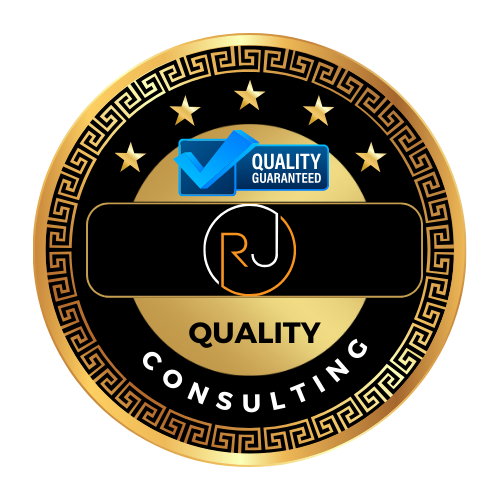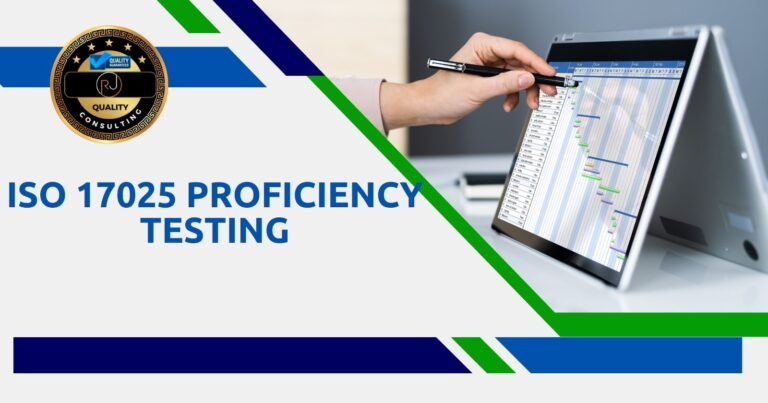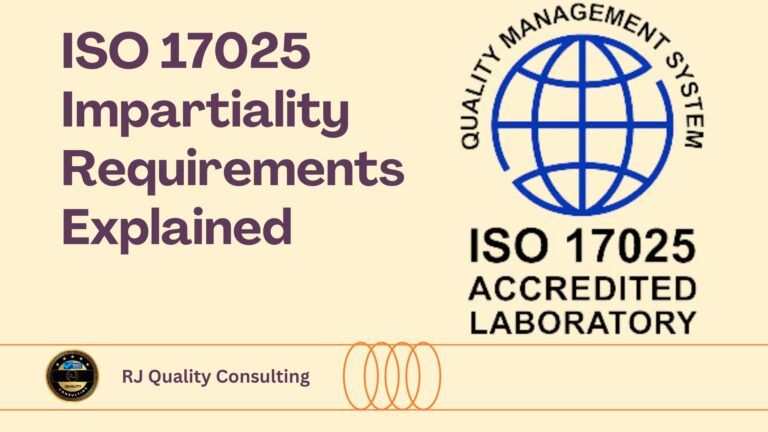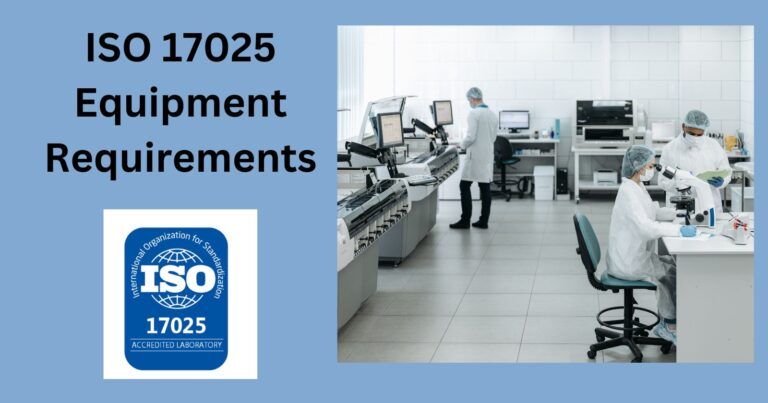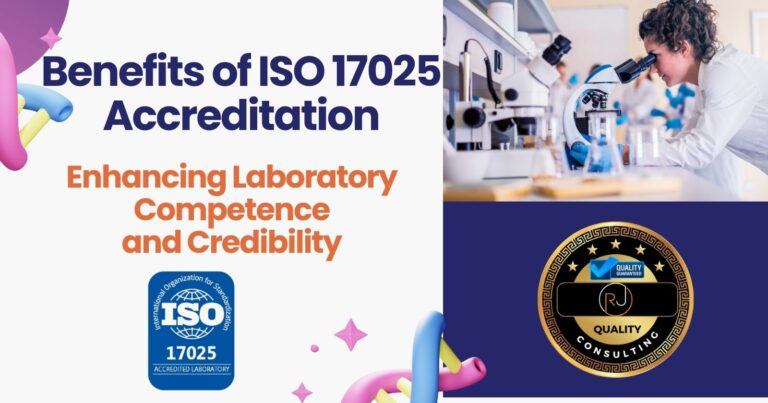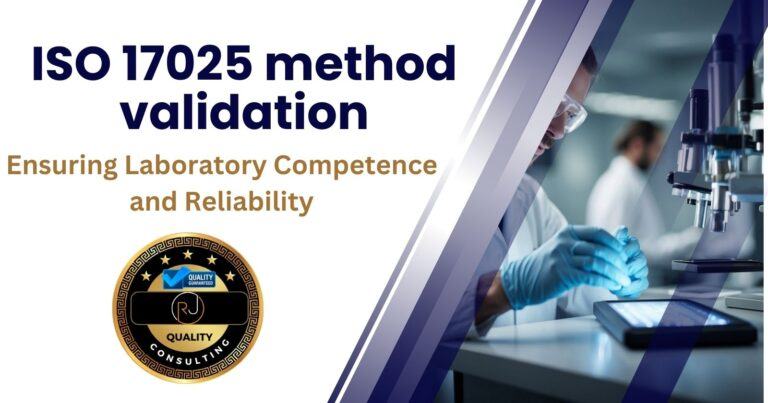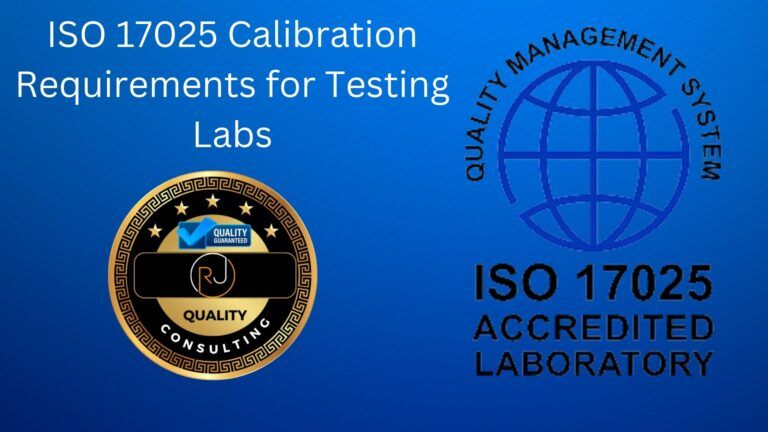Preparing for the ISO 17025 Accreditation Audit: Essential Steps for Laboratory Compliance
Achieving ISO/IEC 17025 accreditation is a significant milestone for laboratories, as it not only boosts confidence in their work but is an official recognition of their technical competency and commitment to quality. The accreditation process involves a thorough evaluation by an accreditation body, scrutinizing everything from your laboratory’s quality management system to its day-to-day operations. In preparing for the ISO 17025 accreditation audit, it is essential to comprehend the standard’s requirements and demonstrate that your lab operates effectively while adhering to these guidelines.

Preparing for the ISO 17025 accreditation audit demands attention to detail and an understanding of the entire process. This includes the testing and calibration procedures your laboratory follows, handling of reports and complaints, and overall adherence to quality management systems. Your readiness ensures a smoother audit process, reducing the likelihood of deficiencies and helping cut potential costs associated with extended assessment time.
Key Takeaways
- Achieving ISO/IEC 17025 accreditation affirms your laboratory’s quality and technical proficiency.
- Preparing for the audit includes understanding every aspect of lab operations and ISO 17025 standards.
- Proper preparation facilitates a smoother audit, minimizing deficiencies and associated costs.
Section 1: Overview of ISO 17025 Accreditation
ISO/IEC 17025 is an international standard that specifies the requirements for the competence of testing and calibration laboratories. It provides a framework for laboratories to develop a quality management system and ensure technical competence and the ability to produce precise and accurate test and calibration data.
Accreditation is a formal recognition by an accreditation body that your laboratory meets the ISO 17025 standard and is competent to carry out specific tests or calibrations. Achieving accreditation enhances your laboratory’s credibility and can increase operational efficiency and customer confidence in your results.
Book a FREE 45-Minute Consultation
During the Consultation We Will Give You a Clear Direction and Path For You to Move Forward with Your Certification or Accreditation Goals
The requirements of ISO 17025 are categorized into two main sections:
- Management Requirements: These are related to the operation and effectiveness of the quality management system within the lab, resembling those found in ISO 9001.
- Technical Requirements: These address the competence of staff, testing methodologies, equipment, and the quality of test and calibration data.
To prepare for accreditation, you must ensure your laboratory’s quality management system is aligned with these requirements. This involves comprehensive documentation, systematic procedures, and clear policies that demonstrate your commitment to maintaining standards of quality and technical proficiency.
Lastly, remember that maintaining ISO 17025 accreditation is an ongoing process, requiring continuous improvement to meet the stringent criteria set by the standard and enforced by the accreditation body. Your laboratory will need to establish a routine of regular assessments and calibrations to remain compliant and uphold the integrity and credibility of your testing or calibration services.
Section 2: Accreditation Process Insights from the Video

When preparing for an ISO 17025 accreditation audit, it’s to your advantage to understand key insights from the available video resources. The audit examines your laboratory’s management system and protocols to ensure they align with the ISO 17025 standards. During the audit, the accreditation body will assess various elements, including quality management, technical competence, and the integrity of your test results.
Your preparations should include a comprehensive document review, which is a critical phase where your documentation is evaluated against ISO 17025’s requirements. This involves ensuring that all procedures, policies, and protocols are documented and accessible. Make certain that your quality manual and procedures manuals are comprehensive and up to date. This is how to implement ISO 17025.
Here are your next steps presented in a summarized manner:
- Internal Audit: Perform an internal audit to identify and correct potential non-conformances. This preemptive step allows you to address issues before the official audit.
- Corrective Action: If you find discrepancies, promptly implement corrective actions to rectify these. Documenting these changes is crucial.
- Prepare Your Team: Make sure all employees are aware of the audit processes and their respective roles. Communicate openly to ensure everyone understands the importance of the audit.
- Process Verification: Verify that all your laboratory processes are in line with the documented procedures and ISO 17025 standards.
Remember, detailed preparation is key to a successful ISO 17025 accreditation audit. Approach the process systematically, and use the insights provided to align your laboratory’s practices with the meticulous standards of ISO 17025.
Section 3: Quality Management System and Laboratory Activities

When preparing for an ISO 17025 accreditation audit, your Quality Management System (QMS) is a critical focus. A robust QMS ensures consistency in laboratory activities, underpinning the quality and reliability of your results.
Management Review: Conduct reviews of your QMS regularly. This helps in aligning laboratory objectives with the management’s vision, ensuring ongoing improvement and preparedness for accreditation.
Key components of management review should include:
- Review of internal audit results
- Assessments of customer feedback
- Evaluation of performance indicators
- Consideration of previous management reviews and their outcomes
- Documentation of any changes in policies or objectives
Laboratory Activities: Your laboratory activities must meet the requirements of ISO/IEC 17025. Ensure all processes are documented clearly, and that they reflect actual practices accurately.
Laboratory activities should emphasize:
- Competence: All personnel must be adequately trained and skilled for their roles.
- Equipment: Maintain and calibrate equipment to assure precision and reliability in results.
- Systems: Implement appropriate systems that support the effective operation of laboratory activities, including testing, calibration and quality control.
Internal Audits: Regular internal audits are vital to discover areas of non-compliance and opportunities for improvement before the accreditation audit.
Focus on these areas during internal audits:
- Procedural adherence
- Corrective and preventive actions
- Equipment operations and maintenance records
Accreditation: Prepare for the accreditation audit by ensuring that your QMS and laboratory activities are not only compliant with ISO/IEC 17025 standards but are also being implemented effectively. This will reflect a commitment to quality across all aspects of your laboratory operations.
Section 4: Surveillance and Reassessment

Following initial accreditation to ISO 17025, your laboratory must undergo surveillance and reassessment to maintain the certificate. The objective of surveillance is to monitor your laboratory’s compliance with the standard over time.
Surveillance Audits
- Frequency: Expect annual surveillance audits to ensure ongoing compliance.
- Focus Areas: The audits will focus on your laboratory’s management system and testing/calibration processes.
Preparing for Surveillance
- Documentation Review: Keep your process and quality manuals updated.
- Internal Audits: Schedule regular internal audits to review practices against the standard.
- Corrective Actions: Address nonconformities promptly.
- Management Review: Evaluate the management system’s effectiveness.
- Continual Improvement: Demonstrate a commitment to improving efficiency and quality.
Reassessment
Every few years, a more thorough reassessment is conducted to renew your accreditation certificate. Similar to the initial audit, reassessment involves a comprehensive review of your systems and processes.
Preparing for Reassessment
- Comprehensive Review: Assess all elements of your laboratory’s operation against ISO 17025 requirements.
- Process Validation: Validate your testing and calibration methods routinely.
- Staff Competency: Ensure ongoing training and competency of staff.
- Objective Achievement: Review your quality objectives and performance indicators.
Remember: Maintain thorough records to provide evidence of continual compliance with the ISO 17025 standard. Your attention to detail during surveillance and reassessment will demonstrate your laboratory’s dedication to maintaining high standards.
Section 5: Understanding ISO 17025 Standard Requirements

When preparing for the ISO 17025 accreditation audit, it is paramount to comprehend the requisites of Section 5 of the standard. The guidelines within focus on the structural needs of your laboratory, ensuring a commitment to an effective management system.
- Legal Entity: Your laboratory must either be a recognized legal entity or part of one. This is foundational to take responsibility for your testing and calibration activities.
- Quality and Impartiality: A dedicated focus on quality management systems and maintaining impartiality is essential. Your policies should underline these aspects to instill trust in your results.
- Personnel: Your team must possess the necessary training and competence. Ensure that:
- All employees are appropriately qualified.
- Continuing training is instituted to maintain high standards of expertise.
- Facilities: Your lab’s environment should be suitable for the testing and calibration activities you undertake. Proper maintenance ensures your facilities support accurate and reliable results.
- Equipment and Traceability: All equipment must be correctly calibrated and maintained. Furthermore, you must establish traceability for measurements to recognized standards.
- Sampling: Your processes for sampling must be well-defined and documented, ensuring the representativeness of samples and the repeatability of tests.
By rigorously understanding and implementing the requirements as per Section 5, you validate your lab’s operational integrity and pave the way for successful ISO 17025 accreditation. Adherence corroborates the precision, competence, and impartiality of your lab, which are cornerstones of a reputable institution in testing and calibration.
Section 6: Testing and Calibration Process Requirements

When preparing for your ISO 17025 accreditation audit, it’s essential to understand the requirements for your testing and calibration processes. ISO 17025 stipulates specific protocols to ensure quality and technical competence in these areas.
Testing and Calibration Procedures
Your procedures should be well-documented and define the steps you take to perform tests or calibrations. These must be comprehensive, replicable, and kept current with technological advances and procedural improvements. Ensure that all methods are validated for their intended use, and deviations are managed accordingly.
Control of Data
Maintain robust data control systems. Clearly document how you collect, handle, and protect customer data. You’re expected to use appropriate, validated software and technology to support reliable and accurate results.
Quality Control
Incorporate routine quality control checks to sustain high standards in your testing and calibration outputs. Participate in proficiency testing and implement internal quality control measures to regularly verify the reliability of your results.
Dealing with Risks and Measurement Uncertainty
Assess risks systematically and implement suitable control measures. Be sure to identify and calculate the measurement uncertainty for each type of measurement and test, as this directly relates to the reliability of your results.
Customer Interaction
Consider customer feedback and ensure that your processes meet the customer’s needs, including clear communication about the service provided and handling complaints effectively.
You must demonstrate compliance with ISO 17025 to the auditors, showing that every part of your testing and calibration work is appropriately designed, managed, and performed consistently. This commitment to excellence reflects not just in meeting the standard’s requirements but also in fostering continuous improvement and customer confidence in your laboratory services.
Section 7: Reporting, Complaints, and Non-Conforming Work

When preparing for your ISO 17025 accreditation audit, focus on Section 7, which deals with three critical areas: reporting of results, handling complaints, and managing non-conforming work.
Reporting of Results
Your laboratory’s reports and certificates should communicate information clearly and accurately. Ensure that results are presented in a format that is easily understandable by the recipient. Validation and verification of data should be meticulously carried out before issuance to uphold the quality system’s integrity. Documentation must indicate if results are based on established methods or non-standard methods which have undergone proper validation.
Complaints
Having a formal process to address complaints is essential. This demonstrates your lab’s commitment to improvement. Your procedure should outline how to assess, decide on actions, and record any complaints. Follow up swiftly and communicate effectively with the complainant to reduce risks and maintain trust.
Non-Conforming Work
Dealing with ISO 17025 non-conforming work involves identifying the issue’s cause and taking corrective actions. Establish a clear process for control and correction, including:
- Cause Analysis: Dig into the root cause of the non-conformity.
- Control: Prevent the release of non-conforming work.
- Corrective Action: Eliminate the cause to prevent recurrence.
- Documentation: Keep records of all non-conformities and actions taken.
Inspect and understand the potential impact of non-conforming work, especially if it has already been reported to clients. This is not only about addressing the present issue but also mitigating future risk and advancing continuous improvement within your lab.
Remember, your objective is to demonstrate a robust, reliable, and responsive quality system during your audit. Keep your documentation organized, your processes transparent, and your communication clear.
Conclusion

Achieving ISO/IEC 17025:2017 accreditation validates your laboratory’s ability to consistently produce precise and reliable test results. At the core of this accreditation is the quality management system (QMS), which ensures the proper execution of processes and maintains a competent workforce committed to continual improvement.
Prioritization of a thorough QMS is paramount. Your QMS should be tailored to drive compliance with the ISO/IEC 17025:2017 standards and to streamline laboratory operations. Emphasis should be placed on documentation—ensure all processes are well-documented, accessible, and comprehensible to all relevant personnel.
Maintaining the competency of your staff is critical to a successful audit. Regular training and assessment will guarantee that your personnel are proficient and up-to-date with the latest standards and procedures.
In preparation for an audit, conduct regular internal audits of your technical and managerial activities. This proactive approach will not only prepare you for the accreditation process but also instill a culture of continuous improvement within your team.
Remember to align your processes with the accreditation requirements, from method validation and equipment calibration to record-keeping and reporting. Accuracy in data processing and integrity in results reporting are the hallmarks of a laboratory that stands apart.
By focusing on these key areas, developing a robust QMS, and continuously enhancing the skills and knowledge of your team, your laboratory will stand in good stead for achieving and maintaining ISO/IEC 17025:2017 accreditation.
Call to Action

In preparing for your ISO 17025 accreditation audit, action from your side is pivotal to the process. As laboratories seeking this accreditation, demonstrating your quality and competence is crucial. Carefully consider the following steps to ensure your readiness:
- Management Involvement: Garner strong support from your management. Their commitment is vital in steering the laboratory towards success, enabling efficient cooperation and resource allocation throughout the accreditation journey.
- Technical Audit: Implement a thorough internal audit program focusing on both managerial and technical aspects. This will help you identify areas for improvement and ensure ongoing compliance with ISO/IEC 17025 standards.
- Quality Management Systems: Develop and maintain robust quality management systems that reflect the standard’s requirements, such as personnel competence and equipment calibration.
Steps in the Application Process:
- Thoroughly review the ISO/IEC 17025 requirements.
- Conduct a gap analysis to uncover areas for improvement.
- Initiate a corrective action plan.
Documentation:
- Compile necessary documentation, including procedures and policies.
- Ensure all records are up-to-date and easily accessible.
Personnel Training:
- Invest in appropriate training for your staff to understand and apply the accreditation requirements effectively.
In essence, the road to ISO/IEC 17025 accreditation demands stringent preparation and an active role from your laboratory. Your dedication will facilitate not just the trade of your services but also elevate your laboratory’s standing in the global marketplace. Fulfilling these standards is not a one-time event but a continuous quest for excellence.
Frequently Asked Questions

In this section, you’ll find targeted responses to common queries regarding ISO 17025 accreditation preparation. These answers have been crafted to give you a concise understanding of the necessary steps and requirements.
What are the essential steps to perform a gap analysis for ISO 17025 accreditation preparation?
To perform a gap analysis for ISO 17025, first, review the standard’s requirements and compare them to your laboratory’s current processes. Identify the areas that do not meet the standard and create an action plan to address these gaps.
How can one obtain ISO 17025 certification for their laboratory?
To obtain ISO 17025 certification, your laboratory must implement a quality management system that meets the requirements of the standard, conduct internal audits, and undergo an external audit by an accreditation body.
What constitutes the five fundamental requirements of ISO 17025 that laboratories must comply with?
The five fundamental requirements of ISO 17025 are: 1) Organizational structure and management responsibilities, 2) Quality management system, 3) Control of records and documents, 4) Review of contracts, and 5) Proficiency testing and interlaboratory comparisons.
What specific preparations are necessary for undergoing an ISO internal audit?
Preparing for an ISO internal audit involves training the audit team, planning the audit schedule, reviewing current processes against ISO 17025 standards, and making necessary improvements to meet compliance.
Can you outline the process a laboratory must follow to achieve ISO 17025 accreditation?
To achieve ISO 17025 accreditation, a laboratory must develop and implement a compliant quality management system, thoroughly train staff, conduct internal audits, address non-conformities, and then select and apply to an accreditation body for external audit and approval.
Who is qualified to conduct internal audits according to ISO 17025 standards, and what criteria must they meet?
Individuals qualified to conduct internal audits per ISO 17025 standards must be impartial and free from any conflict of interest regarding the audit areas. They should have a thorough understanding of the standard and practical auditing experience.
